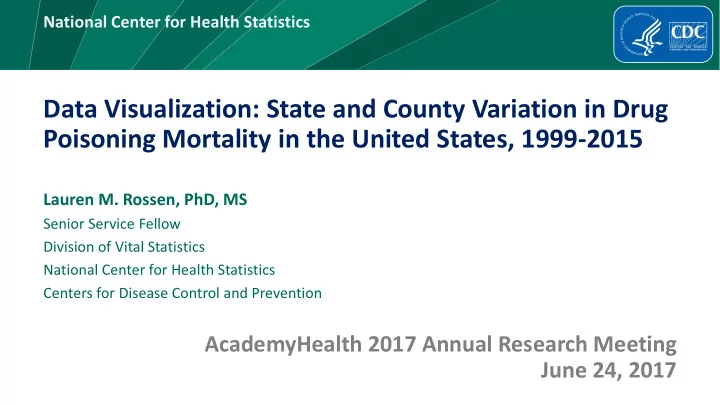

National Center for Health Statistics Data Visualization: State and County Variation in Drug Poisoning Mortality in the United States, 1999-2015 Lauren M. Rossen, PhD, MS Senior Service Fellow Division of Vital Statistics National Center for Health Statistics Centers for Disease Control and Prevention AcademyHealth 2017 Annual Research Meeting June 24, 2017
Acknowledgments & Disclaimer Coauthors: – Diba Khan, Margy Warner, Brigham Bastian, Yinong Chong – SOURCE: Rossen LM, Bastian B, Warner M, Khan D, and Chong Y. Drug poisoning mortality: United States, 1999 – 2015. National Center for Health Statistics. 2017. Disclaimer: – The findings and conclusions in this paper are those of the authors and do not necessarily represent the views of the National Center for Health Statistics, Centers for Disease Control and Prevention
Background Drug overdoses are a major public health concern in the U.S. Drug overdose death rates increased by ~270% from 1999 to 2015 – 6.1 to 16.3 per 100,000 (age adjusted) – Provisional data suggest increases are continuing through the first half of 2016 • 17.5 per 100,000 Recent NYTimes article projected an increase of 19% from 2015 to 2016
DATA VISUALIZATION: DRUG OVERDOSE MORTALITY, 1999-2015
NCHS Data Visualization Gallery Drug overdose death rates for the U.S., 1999-2015 – Examine differences by • Sex, age, race and Hispanic origin • State • County Visualization done using Tableau – Data tables for download as .csv or through Data.CDC.gov SOURCE: https://www.cdc.gov/nchs/data-visualization/drug-poisoning-mortality/
DRUG OVERDOSE DEATH RATES IN THE U.S., 1999-2015 Trends by race and Hispanic origin, sex, and age group
NUMBER OF DRUG OVERDOSE DEATHS IN THE U.S. 1999 2015
NUMBER OF DRUG OVERDOSE DEATHS IN THE U.S. NOTE: • X-axes have dynamic scale: • Above (1999) – • max of 15,000 • Below (2015) – • max of 50,000
STATE-LEVEL DRUG OVERDOSE MORTALITY, 1999-2015
STATE VARIATION IN AGE ADJUSTED DRUG OVERDOSE DEATH RATES In 1999 Highest in: – New Mexico (15.0) – Nevada (11.5) – Maryland (11.4) Lowest in: – North Dakota (1.8) – Iowa (1.9) – Nebraska (2.3)
STATE VARIATION, cont. In 2015 Highest in: – West Virginia (41.5) – New Hampshire (34.3) – Ohio & Kentucky (29.9) All these states had death rates ~ 4-5 in 1999 Lowest in: – Nebraska (6.9) – South Dakota (8.4) – North Dakota (8.6) Incomplete reporting
COUNTY-LEVEL DRUG OVERDOSE MORTALITY, 1999-2015
SMOOTHING COUNTY-LEVEL DEATH RATES Rates are unstable for counties with small # deaths and/or populations Solid sand-colored line is a large city, other 4 counties are rural Data suppressed for counties with < 20 deaths • 87% of counties have data suppressed! Cannot look at sub-state variation using direct estimates (i.e., raw data)
METHODS Hierarchical two-stage models run in Stata using GLLAMM (generalized linear latent and mixed models) – Stage 1: logit model for probability of observing a death – Stage 2: log-linear model for age-adjusted death rates Generate empirical Bayes predictions of annual, county-level age-adjusted death rates (AADR) for 1999-2015 Rossen, LM et al. Trends and Geographic Patterns in Drug-Poisoning Death Rates in the U.S., 1999 – 2009. American Journal of Preventive Medicine , 45(6):e19 - e25.
DATA VISUALIZATION: COUNTY-LEVEL ESTIMATES Can zoom into certain regions/counties:
DISCUSSION
DATA VISUALIZATION: COMMUNICATE HEALTH STATUS IN A SOCIAL CONTEXT Provide information relevant to public health efforts at the state or local level – Inform efforts to address drug overdose mortality Shed light on social factors associated with drug poisoning mortality – Urban/rural disparities – Socioeconomic factors SOURCE: https://evergreen.data.socrata.com/stories/s/Opioid-Crisis-County/jd9m-i84d
HOW IS THIS INFORMATION BEING USED? SOURCE: https://www.gpo.gov/fdsys/pkg/CREC-2016-05-11/pdf/CREC-2016-05-11.pdf
SOME CAVEATS County-level estimates have important limitations: – Can show which areas are higher or lower than others, but should not be used to identify values for any given county or year • We only release ‘binned’ (i.e., categorized) estimates for that reason • Outliers will be ‘smoothed’ toward the overall or local mean – Might not match raw data (i.e., direct estimates) – Might not capture abrupt changes (e.g., pre-post intervention) – May not be the level of geography we want • Is county the appropriate unit of geography to capture social context? – Variation within counties – ‘neighborhood’ or census block level
Questions? Email: LRossen@cdc.gov For data access, see: https://www.naphsis.org/research-requests For more information, contact CDC 1-800-CDC-INFO (232-4636) TTY: 1-888-232-6348 www.cdc.gov The findings and conclusions in this report are those of the authors and do not necessarily represent the official position of the Centers for Disease Control and Prevention.
Extra Slides
Recommend
More recommend